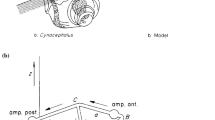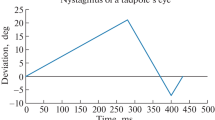Summary
-
1.
Blinded crabs were oscillated about their vertical axis and the eye reflex induced by the fluid-filled statocysts was studied.
-
2.
The phase and gain of the eye movements induced by the eye reflex are affected by the frequency (Fig. 2) and amplitude (Fig. 3) of oscillation and by the pitch position (Figs. 4 and 5) in which the animal is oscillated. Phase lock (eye position in phase to angular acceleration of the body) and a maximal gain (×1) occur when the animal is oscillated in its natural position (20–40‡ head up) at an amplitude of 12.5‡ and a frequency of 0.7 Hz.
-
3.
The movements of the thread hairs relevant for the eye reflex were measured in the isolated but intact statocyst. At oscillations which produce phase lock in the intact animal the position of the hairs is in phase to angular acceleration of the body (Fig. 6).
-
4.
The changes in phase and gain of the eye reflex in the crab which are induced by changes in the frequency and amplitude of oscillation are essentially similar to those obtained in vertebrates. Therefore, it is concluded that the hydrodynamics of the statocyst of the crab resemble that of the vertebrate labyrinth.
-
5.
The changes in phase and gain of the eye reflex induced by positional changes of the crab during the oscillation are explained by gravity affecting the position of the sensory hairs and thereby the properties of their receptors.
Similar content being viewed by others
References
Baarsma, E.A., Collewijn, H.: Vestibulo-ocular and optokinetic reactions to rotation and their interaction in the rabbit. J. Physiol. (Lond.)238, 603–625 (1974)
Fraser, P.J., Sandeman, D.C.: Effects of angular and linear accelerations on semicircular canal interneurons of the crabScylla serrata. J. comp. Physiol.96, 205–221 (1975)
Janse, C., Sandeman, D.C.: The significance of canal-receptor properties for the induction of phase and gain in the fluid-filled balance organs of the crabScylla serrata. J. comp. Physiol.130, 101–111 (1979)
Mayne, R.: A systems concept of the vestibular organs. In: Handbook of sensory physiology, Vol. VI/2. Kornhuber, H.H. (ed.), pp. 494–580. Berlin, Heidelberg, New York: Springer 1974
Melville Jones, G.: The functional significance of semicircular canal size. In: Handbook of sensory physiology, Vol. VI/1. Kornhuber, H.H. (ed.), pp. 171–184. Berlin, Heidelberg, New York: Springer 1974
Sandeman, D.C.: A sensitive position measuring device for biological systems. Comp. Biochem. Physiol.24, 635–638 (1968)
Sandeman, D.C., Erber, J., Kien, J.: Optokinetic eye movements in the crabCarcinus maenas. I. Eye torque. J. comp. Physiol.101, 243–258 (1975)
Sandeman, D.C., Okajima, A.: Statocyst-induced eye movements in the crabScylla serrata. I. The sensory input from the statocyst. J. Exp. Biol.57, 187–204 (1972)
Silvey, G.E., Dunn, P.A., Sandeman, D.C.: Integration between statocyst sensory neurons and oculomotor neurons in the crabScylla serrata. II. The thread hair sensory receptors. J. comp. Physiol.108, 45–52 (1976)
Silvey, G.E., Sandeman, D.C.: Integration between statocyst sensory neurons and oculomotor neurons in the crabScylla serrata. I. Horizontal compensatory eye movements. J. comp. Physiol.108, 35–43 (1976a)
Silvey, G.E., Sandeman, D.C.: Integration between statocyst sensory neurons and oculomotor neurons in the crabScylla serrata. III. The sensory to motor synapse. J. comp. Physiol.108, 53–65 (1976b)
Silvey, G.E., Sandeman, D.C.: Integration between statocyst sensory neurons and oculomotor neurons in the crabScylla serrata. IV. Integration phase lags and conjugate eye movements. J. comp. Physiol.108, 67–73 (1976c)
Ten Kate, J.H.: The oculo-vestibular reflex of the growing pike. A biophysical study. Thesis, Rijksuniversiteit Groningen, The Netherlands (1969)
Author information
Authors and Affiliations
Additional information
C.J. was financially supported by the Free University, Amsterdam and by the I.B.R.O.
Rights and permissions
About this article
Cite this article
Janse, C., Sandeman, D.C. The rÔle of the fluid-filled balance organs in the induction of phase and gain in the compensatory eye reflex of the crabScylla serrata . J. Comp. Physiol. 130, 95–100 (1979). https://doi.org/10.1007/BF00611044
Accepted:
Issue Date:
DOI: https://doi.org/10.1007/BF00611044




